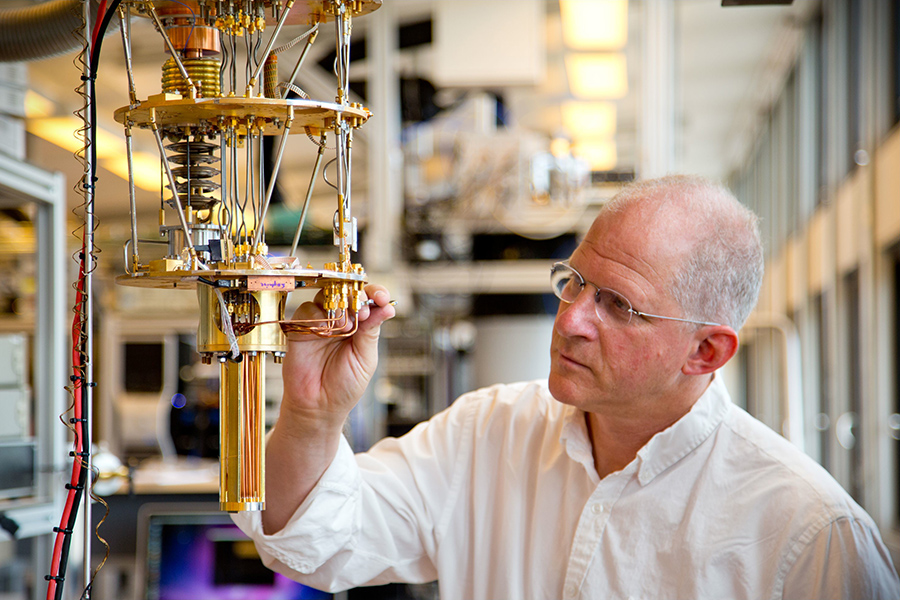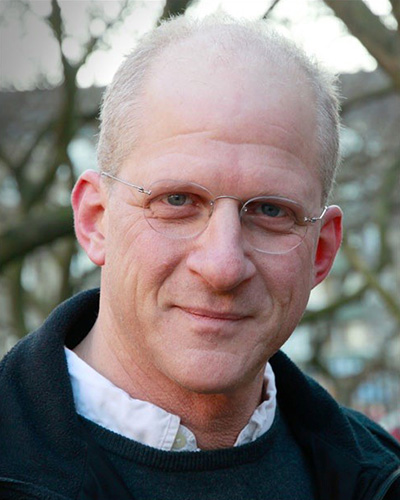By Theresa Gabrielli
March 1, 2023
Asking deep – possibly unknowable – questions has been the driving force behind professor Charles Marcus’s entire life.

Professor Charles Marcus makes adjustments on equipment in his lab at the Niels Bohr Institute in Copenhagen, Denmark. Photo credit: Ola Joensen, Niels Bohr Institute
“I had an opportunity in grad school to ask myself, ‘What’s the most interesting problem I can think of?’” he said. “And the one that came to me was, how does consciousness arise out of an electrical circuit?”
This concept of emergence, or the idea that when you put a bunch of simple elements together, something can arise from them that is not apparent from the outset, has fascinated Marcus ever since. How does a human brain, which is effectively a complicated electrical circuit with lots of tiny parts (neurons), develop free will?

Photo credit: Ola Joensen, Niels Bohr Institute
He began his career working with solid materials at low temperatures and developing semiconductors, and attempting to understand where unpredictability comes from. Today, his primary goal is to build controlled quantum entanglement machines.
Quantum entanglement is a phenomenon in which two individual elements within a system are linked in such a way that the state of each element cannot be described independently, despite the physical distance that separates them. This property is utilized in quantum computing to create a new basic unit of information, known as qubit (pronounced “kyu-bit”). Unlike a classical computing bit, which is only either a 1 or a 0, a qubit can be in “superposition,” meaning both 1 and 0 at the same time. This gives quantum computers the ability to solve some problems at an exponential rate compared to today's standard classical computers.
Without controlled quantum entanglement, quantum computing isn’t possible, and Marcus understood that materials science was key. “The exact right materials will work as quantum,” he said. “But what are those materials made of? And who gets to pick?”
Related story

Accelerating a quantum future
Learn how College of Engineering and College of Arts & Sciences researchers are helping to establish the UW as a global leader of the coming quantum age.
Several UW researchers, including MSE faculty Ting Cao and Juan Carlos Idrobo, are currently working to determine just that. Cao is attempting to predict a material’s properties using quantum physics and advanced modelling techniques. Idrobo uses electron microscopy to view individual atoms within a material to figure out the correlation between its atomic structure and its general, wide-scale properties. According to Cao, the materials that researchers currently believe optimal for quantum computing are silicon superconductors (which have the best potential for scalable manufacturing) and calcium trapped ions (which are able to be controlled and manipulated with high precision).
The applications of a usable quantum computer are, as Marcus put it, “far beyond what I can imagine.” Once we are able to control quantum entanglement, the landscape of everything – data storage, mathematics, medicine, simulations, sensing, energy, and more – will be drastically changed. One day, Marcus hopes, we may even be able to answer that most interesting problem from his grad school days.
Marcus will be joining the UW as a joint faculty appointment between MSE and physics starting in the spring. He says he is excited to reengage with the challenge of teaching, and that one of his favorite things about doing research at a university is “shared a-ha moments.”
He will good-naturedly tell anyone who asks that he is not a materials engineer. And that’s exactly why he wanted to join UW MSE.
“People here know things that I don’t,” he said. “The room doesn’t get smarter when it's just my voice bouncing off the walls. The university is for everybody, and everybody’s here to learn – even us old guys! This place means new science, new ways of engaging. Let’s look together!”